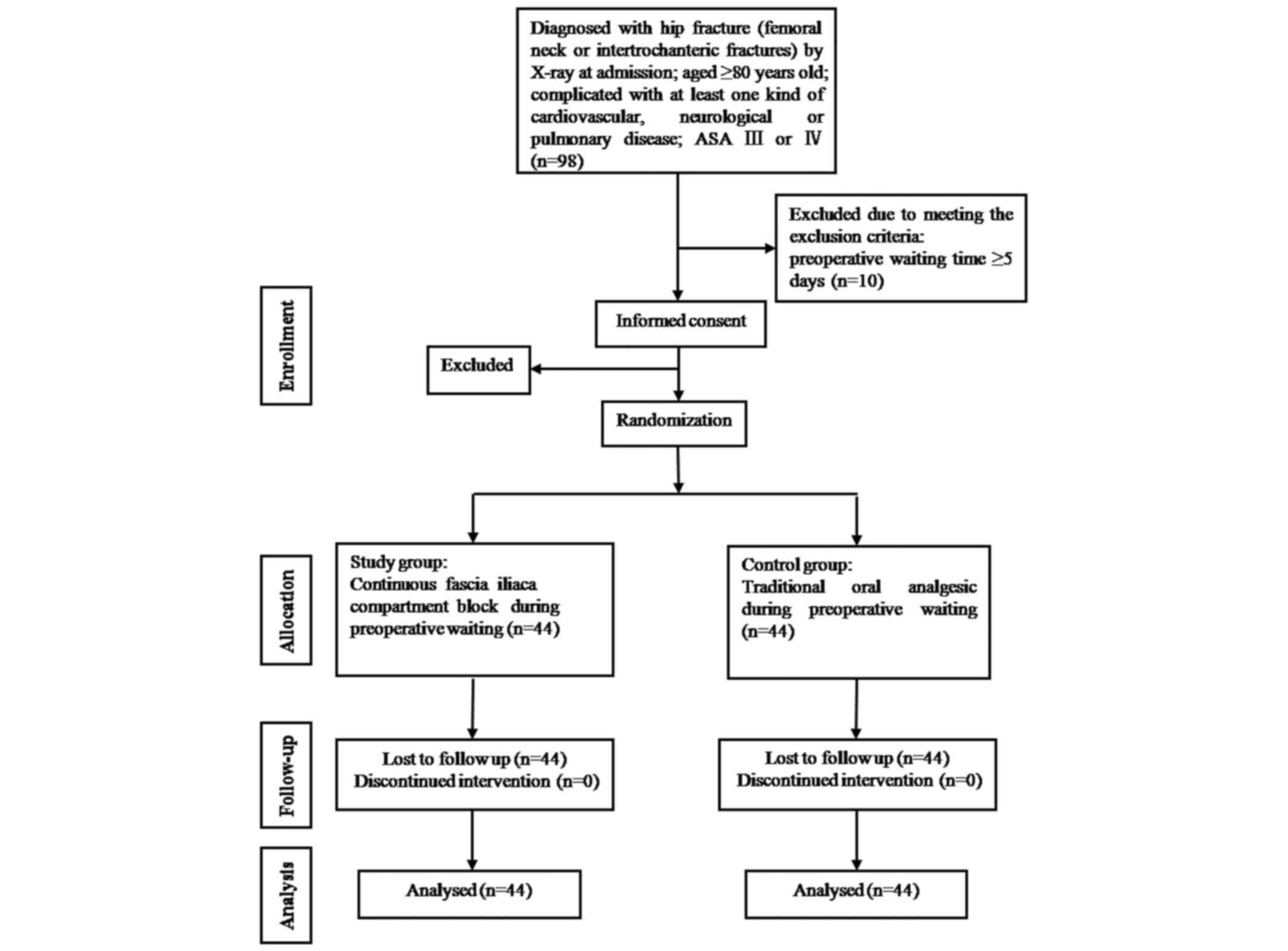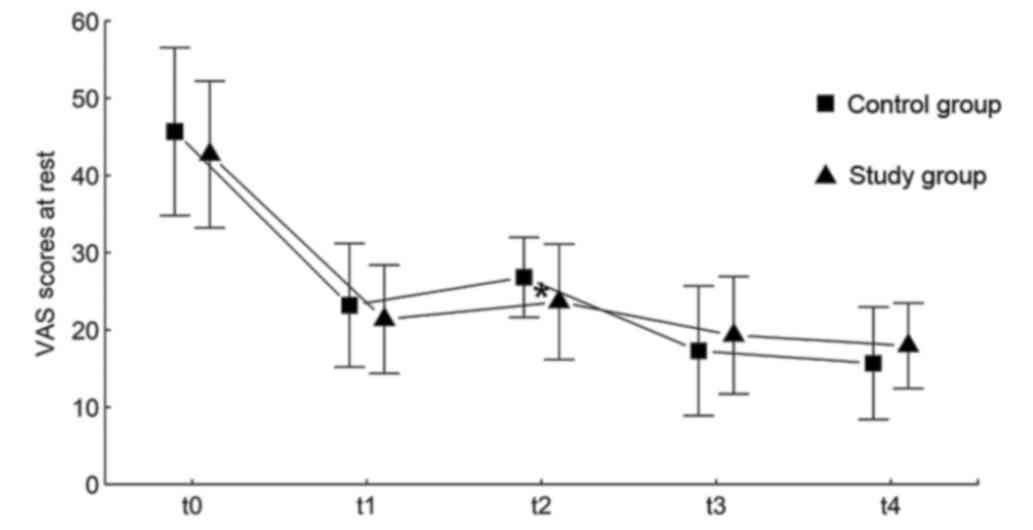|
1
|
Johnell O and Kanis JA: An estimate of the
worldwide prevalence, mortality and disability associated with hip
fracture. Osteoporos Int. 15:897–902. 2004. View Article : Google Scholar : PubMed/NCBI
|
|
2
|
Watters CL and Moran WP: Hip fractures-a
joint effort. Orthop Nurs. 25:157–165; quiz 166–167. 2006.
View Article : Google Scholar : PubMed/NCBI
|
|
3
|
Marks R: Hip fracture epidemiological
trends, outcomes, and risk factors, 1970–2009. Int J Gen Med.
3:1–17. 2010.PubMed/NCBI
|
|
4
|
Boddaert J, Cohen-Bittan J, Khiami F,
Khiami F, Le Manach Y, Raus M, Beinis JY, Verny M and Riou B:
Postoperative admission to a dedicated geriatric unit decreases
mortality in elderly patients with hip fracture. PLoS One.
9:e837952014. View Article : Google Scholar : PubMed/NCBI
|
|
5
|
Rosencher N, Vielpeau C, Emmerich J,
Fagnani F and Samama CM: ESCORTE group: Venous thromboembolism and
mortality after hip fracture surgery: The ESCORTE study. J Thromb
Haemost. 3:2006–2014. 2005. View Article : Google Scholar : PubMed/NCBI
|
|
6
|
Mak JC, Cameron ID and March LM: National
health and medical research council: Evidence-based guidelines for
the management of hip fractures in older persons: An update. Med J
Aust. 192:37–41. 2010.PubMed/NCBI
|
|
7
|
Simunovic N, Devereaux PJ, Sprague S,
Guyatt GH, Schemitsch E, Debeer J and Bhandari M: Effect of early
surgery after hip fracture on mortality and complications:
Systematic review and meta-analysis. CMAJ. 182:1609–1616. 2010.
View Article : Google Scholar : PubMed/NCBI
|
|
8
|
Moja L, Piatti A, Pecoraro V, Ricci C,
Virgili G, Salanti G, Germagnoli L, Liberati A and Banfi G: Timing
matters in hip fracture surgery: Patients operated within 48 hours
have better outcomes. A meta-analysis and meta-regression of over
190,000 patients. PLoS One. 7:e461752012. View Article : Google Scholar : PubMed/NCBI
|
|
9
|
Colais P, Di Martino M, Fusco D, Perucci
CA and Davoli M: The effect of early surgery after hip fracture on
1-year mortality. BMC Geriatr. 15:1412015. View Article : Google Scholar : PubMed/NCBI
|
|
10
|
Association of Anaesthetists of Great
Britain and Ireland, . Griffiths R, Alper J, Beckingsale A,
Goldhill D, Heyburn G, Holloway J, Leaper E, Parker M, Ridgway S,
et al: Management of proximal femoral fractures 2011: Association
of Anaesthetists of Great Britain and Ireland. Anaesthesia.
67:85–98. 2012. View Article : Google Scholar : PubMed/NCBI
|
|
11
|
Tran T, Delluc A, de Wit C, Petrcich W, Le
Gal G and Carrier M: The impact of oral anticoagulation on time to
surgery in patients hospitalized with hip0 fracture. Thromb Res.
136:962–965. 2015. View Article : Google Scholar : PubMed/NCBI
|
|
12
|
Orosz GM, Hannan EL, Magaziner J, Koval K,
Gilbert M, Aufses A, Straus E, Vespe E and Siu AL: Hip fracture in
the older patient: Reasons for delay in hospitalization and timing
of surgical repair. J Am Geriatr Soc. 50:1336–1340. 2002.
View Article : Google Scholar : PubMed/NCBI
|
|
13
|
Kanis JA, Johnell O, Oden A, Sembo L,
Redlund-Johnell L, Dawson A, De Laet C and Jonsson B: Long-term
risk of osteoporotic fracture in Malmö. Osteoporos Int. 11:669–674.
2000. View Article : Google Scholar : PubMed/NCBI
|
|
14
|
Roche JJ, Wenn RT, Sahota O and Moran CG:
Effect of comorbidities and postoperative complications on
mortality after hip fracture in elderly people: Prospective
observational cohort study. Bmj. 331:13742005. View Article : Google Scholar : PubMed/NCBI
|
|
15
|
Jandziol AK and Griffiths R: The
anaesthetic management of patients with hip fractures. Bja Cepd
Reviews. 1:52–55. 2001. View Article : Google Scholar
|
|
16
|
Sciard D, Cattano D, Hussain M and
Rosenstein A: Perioperative management of proximal hip fractures in
the elderly: The surgeon and the anesthesiologist. Minerva
Anestesiol. 77:715–722. 2011.PubMed/NCBI
|
|
17
|
Godoy Monzón D, Vazquez J, Jauregui JR and
Iserson KV: Pain treatment in post-traumatic hip fracture in the
elderly: Regional block vs. Systemic non-steroidal analgesics. Int
J Emerg Med. 3:321–325. 2010. View Article : Google Scholar : PubMed/NCBI
|
|
18
|
Scheinin H, Virtanen T, Kentala E, Uotila
P, Laitio T, Hartiala J, Heikkilä H, Sariola-Heinonen K, Pullisaar
O, Yli-Mäyry S and Jalonen J: Epidural infusion of bupivacaine and
fentanyl reduces perioperative myocardial ischaemia in elderly
patients with hip fracture-a randomized controlled trial. Acta
Anaesthesiol Scand. 44:1061–1070. 2000. View Article : Google Scholar : PubMed/NCBI
|
|
19
|
Matot I, Oppenheim-Eden A, Ratrot R,
Davidson E, Eylon S, Peyser A and Liebergall M: Preoperative
cardiac events in elderly patients with hip fracture randomized to
epidural or conventional analgesia. Anesthesiology. 98:156–163.
2003. View Article : Google Scholar : PubMed/NCBI
|
|
20
|
Luger TJ, Kammerlander C, Benz M, Luger MF
and Garoscio I: Peridural anesthesia or ultrasound-guided
continuous 3-in-1 block: Which is indicated for analgesia in very
elderly patients with hip fracture in the emergency department?
Geriatr Orthop Surg Rehabil. 3:121–128. 2012. View Article : Google Scholar : PubMed/NCBI
|
|
21
|
Foss NB, Kristensen BB, Bundgaard M, Bak
M, Heiring C, Virkelyst C, Hougaard S and Kehlet H: Fascia iliaca
compartment blockade for acute pain control in hip fracture
patients. Anesthesiology. 106:773–778. 2007. View Article : Google Scholar : PubMed/NCBI
|
|
22
|
Fujihara Y, Fukunishi S, Nishio S, Miura
J, Koyanagi S and Yoshiya S: Fascia iliaca compartment block: Its
efficacy in pain control for patients with proximal femoral
fracture. J Orthop Sci. 18:793–797. 2013. View Article : Google Scholar : PubMed/NCBI
|
|
23
|
Candal-Couto JJ, McVie JL, Haslam N, Innes
AR and Rushmer J: Pre-operative analgesia for patients with femoral
neck fractures using a modified fascia iliaca block technique.
Injury. 36:505–510. 2005. View Article : Google Scholar : PubMed/NCBI
|
|
24
|
Dulaney-Cripe E, Hadaway S, Bauman R,
Trame C, Smith C, Sillaman B and Laughlin R: A continuous infusion
fascia iliaca compartment block in hip fracture patients: A pilot
study. J Clin Med Res. 4:45–48. 2012.PubMed/NCBI
|
|
25
|
Viscusi ER and Pappagallo M: A review of
opioids for in-hospital pain management. Hosp Pract. 40:149–159.
2012. View Article : Google Scholar
|
|
26
|
Pedersen SJ, Borgbjerg FM, Schousboe B,
Pedersen BD, Jørgensen HL, Duus BR and Lauritzen JB: Hip Fracture
Group of Bispebjerg Hospital: A comprehensive hip fracture program
reduces complication rates and mortality. J Am Geriatr Soc.
56:1831–1838. 2008. View Article : Google Scholar : PubMed/NCBI
|
|
27
|
Catananti C and Gambassi G: Pain
assessment in the elderly. Surg Oncol. 19:140–148. 2010. View Article : Google Scholar : PubMed/NCBI
|
|
28
|
Chin RP, Ho CH and Cheung LP: Scheduled
analgesic regimen improves rehabilitation after hip fracture
surgery. Clin Orthop Relat Res. 471:2349–2360. 2013. View Article : Google Scholar : PubMed/NCBI
|
|
29
|
Petre BM, Roxbury CR, McCallum JR,
Defontes KW III, Belkoff SM and Mears SC: Pain reporting, opiate
dosing, and the adverse effects of opiates after hip or knee
replacement in patients 60 years old or older. Geriatr Orthop Surg
Rehabil. 3:3–7. 2012. View Article : Google Scholar : PubMed/NCBI
|
|
30
|
Abou-Setta AM, Beaupre LA, Rashiq S,
Dryden DM, Hamm MP, Sadowski CA, Menon MR, Majumdar SR, Wilson DM,
Karkhaneh M, et al: Comparative effectiveness of pain management
interventions for hip fracture: A systematic review. Ann Intern
Med. 155:234–245. 2011. View Article : Google Scholar : PubMed/NCBI
|
|
31
|
Diakomi M, Papaioannou M, Mela A,
Kouskouni E and Makris A: Preoperative fascia iliaca compartment
block for positioning patients with hip fractures for central
nervous blockade: A randomized trial. Reg Anesth Pain Med.
39:394–398. 2014. View Article : Google Scholar : PubMed/NCBI
|
|
32
|
Birnbaum K, Prescher A, Hessler S and
Heller KD: The sensory innervation of the hip joint-an anatomical
study. Surg Radio Anat. 19:371–375. 1997. View Article : Google Scholar
|
|
33
|
Dalens B, Vanneuville G and Tanguy A:
Comparison of the fascia iliaca compartment block with the 3-in-1
block in children. Anesth Analg. 69:705–713. 1989. View Article : Google Scholar : PubMed/NCBI
|
|
34
|
Szucs S, Iohom G, O'Donnell B, Sajgalik P,
Ahmad I, Salah N and Shorten G: Analgesic efficacy of continuous
femoral nerve block commenced prior to operative fixation of
fractured neck of femur. Perioper Med (Lond). 1:42012.PubMed/NCBI
|
|
35
|
Yu B, He M, Cai GY, Zou TX and Zhang N:
Ultrasound-guided continuous femoral nerve block vs continuous
fascia iliaca compartment block for hip replacement in the elderly:
A randomized controlled clinical trial (CONSORT). Medicine
(Baltimore). 95:e50562016. View Article : Google Scholar : PubMed/NCBI
|
|
36
|
Fletcher AK, Rigby AS and Heyes FL:
Three-in-one femoral nerve block as analgesia for fractured neck of
femur in the emergency department: A randomized, controlled trial.
Ann Emerg Med. 41:227–233. 2003. View Article : Google Scholar : PubMed/NCBI
|
|
37
|
Paul JE, Arya A, Hurlburt L, Cheng J,
Thabane L, Tidy A and Murthy Y: Femoral nerve block improves
analgesia outcomes after total knee arthroplasty: A meta-analysis
of randomized controlled trials. Anesthesiology. 113:1144–1162.
2010. View Article : Google Scholar : PubMed/NCBI
|
|
38
|
Monzon Godoy D, Iserson KV and Vazquez JA:
Single fascia iliaca compartment block for post-hip fracture pain
relief. J Emerg Med. 32:257–262. 2007. View Article : Google Scholar : PubMed/NCBI
|
|
39
|
Inan N, Takmaz Akin S, Iltar S, Yazici I
and Basar H: The effects of two different multimodal analgesic
regimens in total hip replacement surgery. Agri. 21:69–74.
2009.PubMed/NCBI
|
|
40
|
Capdevila X, Biboulet P, Bouregba M,
Barthelet Y, Rubenovitch J and d'Athis F: Comparison of the
three-in-one and fascia iliaca compartment blocks in adults:
Clinical and radiographic analysis. Anesth Analg. 86:1039–1044.
1998. View Article : Google Scholar : PubMed/NCBI
|
|
41
|
Newman B, McCarthy L, Thomas PW, May P,
Layzell M and Horn K: A comparison of pre-operative nerve
stimulator-guided femoral nerve block and fascia iliaca compartment
block in patients with a femoral neck fracture. Anaesthesia.
68:899–903. 2013. View Article : Google Scholar : PubMed/NCBI
|
|
42
|
Deniz S, Atım A, Kürklü M, Çaycı T and
Kurt E: Comparison of the postoperative analgesic efficacy of an
ultrasound-guided fascia iliaca compartment block versus 3 in 1
block in hip prosthesis surgery. Agri. 26:151–157. 2014. View Article : Google Scholar : PubMed/NCBI
|
|
43
|
Dolan J, Williams A, Murney E, Smith M and
Kenny GN: Ultrasound guided fascia iliaca block: A comparison with
the loss of resistance technique. Reg Anesth Pain Med. 33:526–531.
2008. View Article : Google Scholar : PubMed/NCBI
|
|
44
|
Ganapathy S, Wasserman RA, Watson JT,
Bennett J, Armstrong KP, Stockall CA, Chess DG and MacDonald C:
Modified continuous femoral three-in-one block for postoperative
pain after total knee arthroplasty. Anesth Analg. 89:1197–1202.
1999. View Article : Google Scholar : PubMed/NCBI
|
|
45
|
Lopez S, Gros T, Bernard N, Plasse C and
Capdevila X: Fascia iliaca compartment block for femoral bone
fractures in prehospital care. Reg Anesth Pain Med. 28:203–207.
2003. View Article : Google Scholar : PubMed/NCBI
|
|
46
|
Hebbard P, Ivanusic J and Sha S:
Ultrasound-guided supra-inguinal fascia iliaca block: A cadaveric
evaluation of a novel approach. Anaesthesia. 66:300–305. 2011.
View Article : Google Scholar : PubMed/NCBI
|
|
47
|
Sanzone AG: Current challenges in pain
management in hip fracture patients. J Orthop Trauma. 30 Suppl
1:S1–S5. 2016. View Article : Google Scholar : PubMed/NCBI
|
|
48
|
Lau TW, Fang C and Leung F: The
effectiveness of a geriatric hip fracture clinical pathway in
reducing hospital and rehabilitation length of stay and improving
short-term mortality rates. Geriatr Orthop Surg Rehabil. 4:3–9.
2013. View Article : Google Scholar : PubMed/NCBI
|
|
49
|
French DD, Bass E, Bradham DD, Campbell RR
and Rubenstein LZ: Rehospitalization after hip fracture: Predictors
and prognosis from a national veterans study. J Am Geriatr Soc.
56:705–710. 2008. View Article : Google Scholar : PubMed/NCBI
|


















